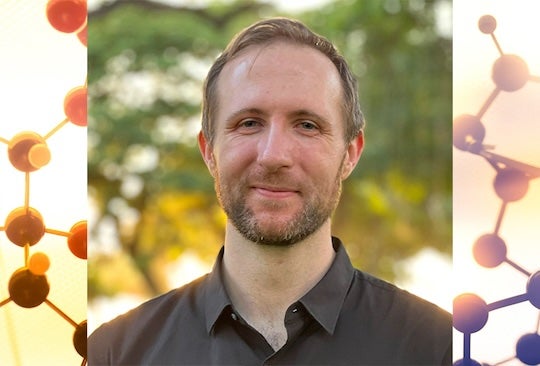by Jade Boyd
Special to Rice News
Rice University chemist Julian West is one of a dozen up-and-coming young scientists featured in Chemical & Engineering News’ (C&EN) 2024 Talented 12, an annual issue of the weekly news magazine that highlights rising stars across all chemistry research disciplines.

West, an assistant professor and the Norman Hackerman-Welch Young Investigator in Rice’s Department of Chemistry, is a synthetic chemist whose lab designs novel chemical reactions. Drawing inspiration from biology, West’s research group has found ways to simplify the production of entire libraries of feedstock chemicals for drug and chemical manufacturers. Not only are West’s methods more sustainable than the mainstay reactions chemical makers have relied on for decades, they use catalysts that are far cheaper than the gold, palladium, rhodium and other rare-metal industry standards.
West is the third chemist named to C&EN’s Talented 12 from Rice’s Wiess School of Natural Sciences in four years. Associate Professor Hans Renata, whose lab works at the interface of organic synthesis, enzymology and natural product chemical biology, made the 2021 list. Assistant Professor Raúl Hernández Sánchez, whose lab combines supramolecular, organic, inorganic and materials chemistry, was featured in 2023. C&EN is the American Chemical Society’s flagship news magazine.
The West lab’s notable achievements include a reliable and cost-effective “catch-and-attach” process for adding fluorine to molecules in drug production. Fluorine can increase a drug’s absorption and prolong its lifetime, but adding it has typically required chemicals that are expensive and highly reactive. West’s team found a way to attach fluorine atoms to alkene feedstocks via an alkylation reaction that is catalyzed by iron and sulfur.
“Nature makes all of these really amazing, complicated molecules, and it does it using the most common elements like iron, cobalt and sulfur, basically the elements in dirt,” West said. “The question that motivates our group is, ‘Can we bring lessons from nature into methods that chemists use to make molecules?’”
West said the 2023 paper was particularly gratifying for several reasons. First, it built on a number of breakthroughs led by different students and postdoctoral researchers in the group over the previous five years. Second, it brought them together in a reaction that was simple, cheap and extraordinarily useful.
“What got us really excited about that reaction was that it allowed us to mix and match all these different kinds of alkenes and fluorine-containing fragments,” he said. “Using really simple iron and sulfur catalysts and a little bit of light, we found we could make a huge library of molecules. Basically, we didn’t really find a case where the reaction didn’t seem to work.”
Another breakthrough from West’s group was a process to produce alkene precursors, also known as olefins, via a light-driven process using vitamin B12. The 2021 study in Chemical Science was inspired by the 2015 discovery of a vitamin B12-containing enzyme that some bacteria use to detect light. The olefin-producing process developed by West and postdoctoral researcher Radha Bam eliminated the need for harsh chemicals, like caustic bases, that have been used in olefin production for more than a century.
As opposed to the ionic reactions that have dominated industrial chemistry since its inception, West’s group and others seek to use reactions that have unpaired electrons, which are also known as radicals. Radicals are shunned in traditional ionic chemistry, which has dominated the chemical industry since its inception.
“Our understanding of radical interactions and more broadly of the organometallic chemistry that drives them has really only started to get more sophisticated in the last 40 years,” West said. “And really, there’s been a huge acceleration in the last 10 or 20. As we’re learning more and more about them, what we’re finding is they can also be very clean and very selective and not make all of the byproducts that are produced by ionic processes.”
- Image downloads:
-
https://news-network.rice.edu/news/files/2024/05/West.jpg
CAPTION: Julian West, an assistant professor and the Norman Hackerman-Welch Young Investigator in Rice’s Department of Chemistry, is one of a dozen up-and-coming young scientists featured in Chemical & Engineering News’ (C&EN) 2024 Talented 12. (Photo courtesy of Julian West/Rice University) - Related stories:
-
Vitamin boosts essential synthetic chemistry – Dec. 8, 2020
https://news.rice.edu/news/2020/vitamin-boosts-essential-synthetic-chemistryLab lights way to simple chemical synthesis – Jan. 5, 2023
https://news.rice.edu/news/2023/lab-lights-way-simple-chemical-synthesisProcess to customize molecules does double duty – June 22, 2022
https://news.rice.edu/news/2022/process-customize-molecules-does-double-dutyFluorince catch-and-attach process could boost drug efficiency – Nov. 13, 2023
https://news.rice.edu/news/2023/fluorine-catch-and-attach-process-could-boost-drug-efficiency
- Links:
-
West lab: westchem.org
Department of Chemistry: chemistry.rice.edu
Wiess School of Natural Sciences: naturalsciences.rice.edu
C&EN Talented 12 2024: cen.acs.org/people/profiles/CENs-Talented-12/102/i15

